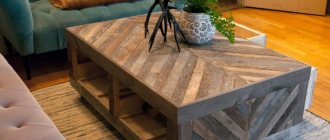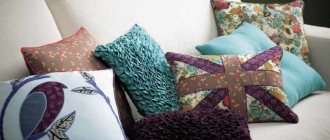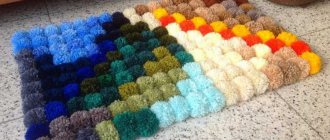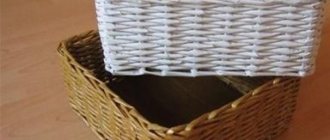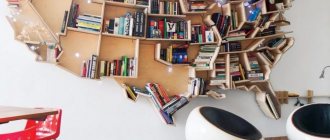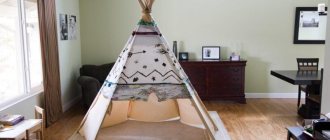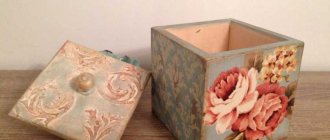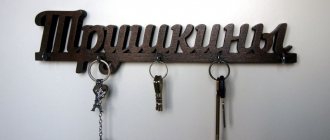A bench for relaxing in the fresh air should be on any local area. They use different materials for it, but more often we are talking about the symbiosis of metal and wood - a durable frame is made from the first, and the flooring for it is made from the second.
Benches made from profile pipes are popular; this material has many advantages, and the result is of high strength and quality.
A simple do-it-yourself metal bench covered with wood
Advantages of a metal bench
- The metal structure is able to evenly distribute the load, unlike the models presented above. Withstands constant and variable loads. This is considered its main advantage.
- The backrest can be attached in different ways, the main thing is that all actions meet certain requirements. In addition, in the event of a sudden defect, you do not have to worry about further suitability for use. Even in such conditions, the structure is capable of fulfilling its purposes.
- In addition, there is the opportunity to “swing” in terms of creating a design. But do not forget that in every device, sooner or later, shortcomings can be discovered. Here they are expressed in large dimensions and low complexity in reproducing the design.
- The manufacturing process requires a minimal amount of material. All you need to buy is a solid board, metal sides and a support piece. Its thickness should be 40 millimeters and its length up to two meters. As for the width, the desired figure is no more than 45 mm; the use of metal fasteners cannot be neglected.
Guide to building a bench from profile pipes
A bench without a back is a simple structure that is created in stages:
- The supporting elements of the structure are welded to each other, with short sections placed vertically and long sections horizontally. When working with a welding machine, only right angles are created between the supports;
- The welding seams made are smoothed with a grinding machine and primed with a special compound;
- Pipes serving as a frame are welded to the supports, after which the resulting seams are polished;
- In the frame profiles, 8 holes are made with a drill - holes for fastening elements that will connect the metal frame with the wooden beams of the seat;
The frame of the bench is welded and the bars are bolted - The metal structure is coated with paint that protects against corrosion;
- Wood materials are treated with stain or varnished and attached to a metal frame.
The wood is painted and fixed to the frame, and the legs of the structure are made comfortable
If the seat is intended to be made of metal, then rectangular pipes are used instead of bars. They are welded to the skeleton of the structure and treated with a coloring emulsion.
Other actions are performed when making a bench with a back:
- The crossbar is connected by welding to two pipes 35 cm long. The pole, fixed between the two supports, is placed perpendicularly. It should be in the middle of both sections of profiles;
- Bent pipe segments 78 cm long are attached to the metal structure. According to the rules, welding seams are created in places where the profiles bend;
- The frame is supplemented with the front parts of the support, while the soldering point for the base of the seat and the supporting elements is made at a place 9 cm away from their front zone;
- The structure is strengthened by connecting the crossbar with profiles that serve as front supports;
- 2 arc-shaped pipes are welded between the supports, after which pads are soldered to the edges of the legs;
- The areas that have been welded are sanded with a machine, and all frame parts are coated with a primer. After it dries, anti-corrosion paint is applied to the metal surface;
- Boards are placed on the metal frame. The back of the bench is created from thin wooden elements, and the seat from thick wooden elements. The boards are attached to the frame with bolts.
The structure is made of 6 profiles and 5 boards
Wanting to make the bench comfortable and original, armrests are attached to it. They are 2 pipes of 75 cm each, bent with a special tool. The armrests are welded to the seat frame.
Metal bench - bed
There are free bench plans to help you build a bench for any room in your home or outdoor patio or deck. When you're finished, you'll have a high-quality bench that will cost you less than a store-bought one.
The free plans contain everything you need to plan and complete your metal bench plans. Drawings, step-by-step instructions, cut lists, materials lists and diagrams will guide you through this beginner metalworking project.
You can build a garden bench made of metal, with or without a backrest. The bench is constructed from metal and various types of wood, some painted and others not. With all these options, find the perfect bench plan for your home.
The built bench can be used to store shoes. This storage bench has been designed to easily accommodate four large storage drawers. This adds plenty of storage space for shoes, hats and gloves, sports equipment and anything else the family needs quick access to.
This bench can be used alone or together with a dining table, farm table or picnic table.
Recommendations for decorating the product
The easiest way to decorate a bench made of profile pipes is to cover it with paint. To do this, you can use not only standard black paint. It all depends on wishes and possibilities. An additional decoration for a metal bench can be climbing plants planted around it, for example, grapes.
If it is assumed that the bench will be an element of the recreation area, then next to it you need to place a table made of plastic or wood. It is recommended to place the bench itself near a pond, fountain or flower bed. A good design option for a metal bench is to create and locate it near a structure made from hedge profiles.
This structure remains to be covered with polycarbonate
When creating a bench for a children's corner, you should place a swing or a sandbox nearby. If adults need a bench, then it should be placed in a gazebo or covered with a canopy. It is recommended to lay a blanket on the seat, which will make the metal bench soft. In addition to the bench, you can place a table and barbecue in the recreation room.
Required Tools
- saw (for cutting wood if it is too long);
- screws;
- roulette;
- manual grinding machine;
- pencil;
- eye and ear protection.
Simple corner bench against the wall
Even the smallest corner of your garden plot can be easily turned into a place for a pleasant rest if you decorate it with plants and place a bench there. The less free space you have, the simpler the construction should be. In our case, together with a small wooden wall that will fence off the raised flower bed, we will install the most ordinary corner bench.
You don't need to be an experienced carpenter to build it. And you will need few materials, especially since part of the support load can be placed on the wall.
Materials and tools
To implement this project on your territory you will need:
- 16 bars with a cross section of 52×52 mm and a length of 2.5 m.
- 46 wooden fence strips 8.9 cm wide, approximately 1.9 m long.
- Sealant for working with external wooden surfaces (putty of increased water resistance).
- 4 cm screws. If possible, use galvanized fasteners. They have a long service life when kept outdoors.
- Nails.
- Pocket hole screws.
- 120 grit sandpaper.
- Stain.
- Finish paint or varnish.
- Drill with a set of drills.
- Hammer.
- A circular saw.
- Pocket hole jig.
- Grinder machine.
- Roulette.
- Square.
- Building level.
- Pencil.
Use the data in the list to cut out the parts. To build a flowerbed fence, which will simultaneously serve as a backrest and additional support, you will need pieces of timber with a cross-section of 51x51 mm: 3 pieces of 1.905 m each; 3 by 1.283 m; 3 x 83.8 cm; 3 – 62.2 cm; 5-1.219 cm. For the bench, cut from timber of the same size: 1 piece 1.943 m; 1 piece 1.422 m; 2 parts 1.207 m each; 2 – 44.1 cm; 4 – 40.6 cm. From planks 8.9 cm wide, prepare 46 planks of 1.219 m each and 30 bench seat planks of 52 cm each.
Before starting assembly, lightly sand the prepared parts. Arrange them in a sequence that is convenient for you. Free the installation area as much as possible from unnecessary objects and dirt.
Description of work
- Start building a wooden fence. Assemble each part of the wall separately onto horizontal base strips. Place the planks one next to the other as closely as possible. Use screws and glue. The pocket method of fastening parts will provide additional protection from moisture and temperature changes.
- Assemble the fence using 5cm screws and glue, attaching the pieces to the sides of the vertical bars. Make sure that the connection angles (especially the central parts) are 90 degrees. Otherwise, difficulties will arise with assembling the bench.
- Separately, assemble the seat frame on a clean, level surface. Use screws and glue. Check that the angle of connection of the parts must be straight.
- Install the frame onto the legs with screws and glue. Use a spirit level to ensure the seat is in the correct position. Secure the legs that are located near the fence by attaching screws to the slats. Also additionally secure the position of the rear part of the frame to the wall.
- Attach the seat strips to the top of the frame using glue and nails. Install the parts tightly next to each other.
- Fill holes from fasteners, uneven areas, etc. with filler.
- Run the sander over the surfaces. Pay especially close attention to the places you will touch during operation.
- Treat the wood with a protective compound. Leave the products to dry completely.
- Depending on your desire, use paint or varnish as a finishing coat.
Assembly instructions
Select bench legs and buy a piece of wood for the seat. A quick search online will help you find a place near you that sells the seat! When it comes to bench supports, opt for thick steel legs. You can find a store and order legs with the exact width and height! Attach the legs to the wooden board using furniture screws. To do this, you will have to drill holes in the metal legs and in the board.
After the bench is ready, the wood can be stained with a color stain (there is a wide choice available). The metal legs should be coated with black paint.
Note!
Blinds for gazebos: wooden, metal, bamboo. Instructions for installing blinds yourself
Adding a terrace to your house with your own hands: step-by-step instructions on how to easily and quickly add a veranda or terrace (100 design photos)
How to attach a veranda to your house with your own hands - step-by-step instructions from A to Z + photos of new designs
Instructions if you decide to make a bench without buying ready-made legs:
- It is better to take square pipes and cut them according to the drawings or personal preferences. You should consider who the bench is being created for (for a family with children, only for adults, for tall people, for very overweight relatives).
- Solder the pipes: two large squares serve as bench legs and armrests. A long pipe is soldered between them, onto which a wooden board for sitting will be attached.
- Solder the back of a square pipe (in the shape of a rectangle, plank or other shape) to the squares.
- Screw the board to the seat and cover it with colored stain.
- Paint the metal parts of the bench with black paint. All!
Finishing the bench after its assembly
After the entire structure is assembled, you can simply paint it with special paint for iron. It is recommended to treat the wooden slats of the seat and back using varnish or stain, and then the bench will acquire a beautiful natural color. This bench will look great on any garden plot. The decor is chosen taking into account the landscape design.
Painting the elements of the bench with a spray gun will help give it a noble golden hue
You can sew soft, comfortable pillows and bedspreads for the backrest yourself. Children and elderly people will find it very comfortable to sit on them on warm summer days.
Hanging bench for rest
It looks like there is a hook screwed into the ceiling. On it hangs a bench suspended from ropes. If your vision of the perfect summer involves sitting on the porch with a cold lemonade and a good book, you'll want to add a fun hanging relaxing bench to the equation. With just a few metal pipes, canvas fabric, strong rope, and a support hook, you can build this stylish rocking bench in no time. It's the perfect place to relax in the summer, read magazines and sip lemonade.
What you need:
- 3 metal pipes 1.5 meters long and about 10 cm wide;
- two wooden sticks 5 cm wide and 1.5 meters long;
- rope (make sure the weight limit is at least 300 kg);
- hook (make sure the weight limit is at least 300kg);
- canvas, which is used as a seat;
- drill;
- tape measures, scissors.
How to do it:
- Cut five metal pipes 1.5 meters long and about 10cm wide. If you want more color contrast from the canvas, paint all five metal pipes.
- Cut a piece of thick fabric measuring 2 x 1.3 meters. Fold the shorter edge of the fabric over and stitch so that you can thread the pipe through. Do the same on the other side of the short edge of the fabric. Thread the two tubes into the fabric (at the short edges). You should have a seat: fabric with pipes inserted along the short edges (one pipe from each edge 1.3 meters). Now, for the stability of the structure, we thread two more wooden pipes perpendicularly into the metal pipes. To do this, you need to make holes in the metal pipes, stepping back 10 cm from the edge. We insert a wooden stick into these holes from the left side. We screw it to a metal rod. Now do the same on the right side. The seat is ready. At the top and bottom there are metal pipes threaded through fabric, and on the sides there are wooden sticks for stability of the structure. Now the seat needs to be hung.
- Drive a metal hook into the ceiling.
- Hang the rope in the hook: thread the 6 meter rope in the middle into the hook. The ends should be 3 meters on each side.
- Tie a third metal stick under the hook: tie ropes down from the hook at the ends of the stick. Place the ropes down and hang the top of the seat around the edges.
- Tie the lower part of the seat on each side to the third stick under the hook. All is ready. The bench is ready.
- Trim the excess rope (you can leave some rope hanging again if you like). The ends of the hanging rope can be unraveled and fluffed for decoration.
How to make it yourself
Most benches made from profile pipes are made of metal with wooden elements (back and seat). You can make structures without a backrest and with one at home, but for this you will need the following tools: a welding machine and electrodes for it, an angle grinder, a drill, a file, a screwdriver, pliers, a hammer, bolts, nuts, nails. As for materials, the need depends on the choice of the type of bench: profile pipes, boards, ready-made forged or fabric parts. We will present you with instructions for making two types of structures - with and without a backrest.
With backrest
To make this type of bench you will need profile pipes and pine boards. The size and cross-section of the pipes will depend on the dimensions and manufacturing features. For a conventional design, corrugated pipes with a cross-section of 25×25 mm (about 8 m) and boards about 3 cm thick are taken. For supports under the back, you will need pieces of bent pipe that can be bent using a vice. Manufacturing stages:
- Cooking the crossbar. The central jumpers are attached at right angles.
- It is necessary to weld bent pipes to the finished part along the bends to support the backrest.
- Installation of the front supporting parts of the structure to the workpiece. For greater strength, the front support blanks are welded to a pipe, which will become a transverse bridge.
- Then two arcs are welded between the supports, which are secured at the base of the legs.
- Grinding of welding seams, priming of the structure and coating with anti-corrosion paint.
- Drill holes for attaching boards.
- Processing of wooden parts for the back and seat - cover the boards with stain or varnish.
- Place the boards on the metal blank at equal intervals, parallel to each other.
- Secure the boards using special bolts with wide round heads. For sitting, you need to choose strong, thick boards; for the back, you can take a little thinner ones.
- The decor of the product is selected according to taste preferences.
Instead of boards or beams, you can use rectangular metal pipes, and for convenience, place pillows covered with leather or waterproof fabric on them. You can also weld armrests for convenience. To do this, you will need to bend two pieces of pipe at an angle of 90° and weld them on the sides. And then process it as the main workpiece.
Without backrest
For the manufacture of such a structure, corrugated pipes with a cross section of 30×30 mm are recommended. A solid pipe is divided into the necessary parts using a grinder.
Follow the following algorithm of actions:
- Weld two rectangular supports at right angles.
- Weld the lintels to the prepared supports.
- Clean the seams with a grinder or sandpaper.
- Prime the frame or coat it with protective enamel.
- Drill holes for attaching wooden seat parts. Metal pieces of corrugated pipes are welded to the main frame.
- Treat boards or beams for sitting with an antiseptic and cover with stain or varnish.
- Secure the boards with hardware.
Further work on the product depends entirely on your taste preferences. You can leave everything as it is in its natural form, or you can completely paint the structure with paints or apply patterns using stencils. The all-metal structure can be supplemented with pillows for comfortable rest, which you can also make yourself. To prevent your beautiful bench from making others want to borrow it without asking, it is better to secure it. If there is a fence nearby, supports can be welded to its base. Also, the supports can be bolted to the bases, which are placed in the wells and concreted.
A woman can make a bench out of metal
The goal is to independently build a collapsible metal bench.
Instructions:
- Draw the bench we want.
- We order a forged base (seat, back, armrests). The base should look like part of a collapsible wrought-iron bed. You can buy ready-made forged sidewalls with drilled holes for the seat. When purchasing, you should consider the length of the bench. For long benches, you should buy more than two supports.
- We fold the bench.
- We sew the seat for the bench ourselves or buy a ready-made mattress. The seat filler can be sawdust scented with lemon oil.
The bench is ready!
Note!
Do-it-yourself columnar foundation for a gazebo: detailed instructions from A to Z + photo
DIY economy class garden gazebo - instructions on how to build quickly and cheaply. Photos, diagrams, drawings, layout and design
Do-it-yourself garden path using a mold: a review of original and inexpensive ideas + step-by-step instructions with photos
Benefits of the bench:
- soft seat, unlike wooden benches;
- collapsible bench (for the winter you can assemble and hide the entire bench).
Calculation of the quantity of materials
Usually, the production of a medium-sized bench takes at least 11 m of profile pipe with a cross-section of 30×30 mm, because to create a bench without a back you need the following parts:
- 6 pieces of profile 60 cm long (long elements of rectangular supports);
- 6 pieces of 45 cm each (short fragments of the structure);
- 2 blanks of 2.3 m each (frames for the seat and fastening the supports).
Making a bench requires a minimum of materials
In addition to metal parts, when creating a bench without a back, you will need wooden blanks:
- 8 rectangular bars 6 cm wide;
- bolts with a flat round head and nuts (16 pieces each).
If you want to make a bench with a back, you will need to purchase 25 mm and 30 mm thick boards and at least 8 m of profile pipes with a cross-section of 25×25 mm from a hardware store.
A pipe is a material for cutting fragments of the skeleton of a bench, that is, the following parts:
- crossbar located between the supports and equal to 1.55 m;
- 2 pieces 35 cm long, from which the base of the seat is created;
- 2 bent parts with a height of 78 cm and a bending span of 10 cm, necessary to create the back and rear fragments of supports;
- 2 metal parts 39 cm long - pieces for the front supports;
- 2 pieces of 20 cm each, serving as clamps for supports located in front;
- 4 support heels measuring 40x40 mm - ordinary metal plates;
- 2 bent metal strips 45 cm long, which solder the supports on both sides.
To create this version of the bench you need a lot of materials
The following materials will be needed to create a bench seat with a back:
- 3 boards 1.6 m long, 60 mm wide and 25 mm thick;
- 3 wooden blanks 1.6 m long, 60 mm wide and 30 mm thick;
- nuts and bolts with a round head (24 pieces each).
Bench protective covering
Wood and metal are processed separately. It is better to use a primer for the frame. Ideally, red lead will be used, which will protect the metal frame from corrosion for decades. Especially when you consider that at the dacha such garden furniture is under the snow for six months.
The wood can simply be painted. But if you first dry it, let it dry for a couple of days, then apply varnish in two layers, then such a coating is guaranteed to protect the wood from environmental influences.
In any case, color compatibility and design ideas are important. For example, if the frame is covered with Kuzbasslak, then it is better to varnish the wooden parts, this will emphasize the natural texture of the material.
To make the protection of the bars effective, the treatment is carried out before fixing to the frame.
Corner bench with table
A small corner bench with a decorative table in the middle is a beautiful and practical decoration for your home.
It must be said that such a design would be appropriate not only on the street, but also in the hallway or on the balcony. Simplicity of lines and massive details are skillfully combined with finishing in contrasting colors and an original way of laying a miniature tabletop.
What you need for work
- 2 boards 51x152 mm, 2.5 m each;
- 7 planks 51x102 mm, 2.5 m long;
- 1 beam 51x51 mm, length 1.9 m;
- 6 cm screws;
- 6 cm screws;
- pocket hole jig;
- tape measure, square, pencil;
- drill with a set of drills;
- grinding machine with attachments;
- masking tape;
- primer;
- wood glue;
- white acrylic paint (can be used in aerosol);
- acrylic lacquer;
- brushes;
- stain.
Use the data from the list below to cut the parts:
- 2 parts 51x102 mm, length 101.6 cm.
- 2 blanks for a frame 51x102 mm, 68 cm long. At one end of each, make a bevel at an angle of 45 degrees.
- 6 parts 51x102 mm, length 67.3 cm.
- 9 leg blanks with parameters 51x102 mm, length 40.6 cm.
- 4 elements of the top of the table 51x102 mm, 38.1 cm each.
- 4 parts 51x102 mm, length 20.3 cm.
- 4 parts 51x51 mm, 45.7 cm each.
- 1 blank for the top of the table 51x102 mm – 32x32 mm.
- 2 parts 51x127 mm, length 67.31 cm;
- 2 blanks 51x127 mm, 38.7 cm each. One end of each part is cut at an angle of 45 degrees.
- 2 elements 51x127 mm, 34.9 cm long with one end beveled at 45 degrees.
- 2 parts 51x127 mm, 31.1 cm each.
Before starting work, sand the parts. If necessary, align the ends of the planks from which the seats and tabletop will be assembled. This is necessary for a better fit of the parts. Prepare your work area. It should be smooth and clean.
Description of the order of assembly and finishing of the product
- Start by building the frame for the bench. First, assemble the frame from 2 pieces of 101.6 cm, 2 of 31.1 cm, 2 of 68 cm. For the correct sequence of connections, check the image below. Prepare pocket holes. Apply glue to the joints, then fasten the parts with screws. Remove excess glue from the surface. Check the correct angles of the structure.
- Prepare holes on the parts that are installed inside the structure. Attach the 31.1mm strips using screws and glue.
- Proceed to install the legs. Place the frame face down on a flat surface. Place 2 prepared parts inside each frame compartment, only in the corner one you will need one - in the outer corner. Mark locations for fastenings. Using a special jig, make holes for the pocket screws. After applying the glue, attach the legs. Use 2-3 5cm screws per connection.
- Create a rectangle for the corner table from pieces of wood: 2 x 38.7 cm with one 45 degree mitered corner, 2 x 34.9 cm also with one 45 degree mitered corner and 2 x 31.8 cm. Drill two pocket holes each at each end of two 38.7 cm boards. Also, make two pocket holes in the side of each of the four pieces that are used to assemble the box. Use pocket screws and wood glue. Be sure to make sure that the pocket holes on the side of each piece are made in the same direction. This is necessary to attach the box to the frame.
- Using wood glue and pocket screws, attach the desk drawer to the boards that make up the corner of the frame.
- Drill two pocket holes in the ends of each of the two 12-inch boards. Turn the bench upside down. Then, using wood glue and 5cm hole screws, attach them to the inside top of the desk drawer.
- At this stage, you can finish the finished part of the structure. Sand the wood surface. Remove dust. Cover the product with primer. After drying, paint the finished frame with white paint. The work can be done with a brush or sprayed. In the latter case, the coating is more uniform.
- Prepare pocket holes for installing seat strips (8 x 27.3 cm: 6 with sections 51x102 and 51x127 mm). Using wood glue and pocket joint screws, attach three 51x102mm and one 51x127mm together to make two seats.
- From the remaining parts (4 x 45.7 cm, 4 x 38.1 cm, 4 x 20.3 cm and a central one 32x32 mm) you should assemble a cover for the table. Make pocket holes. On a flat surface, assemble the mini-tabletop using screws and glue. Just glue the last, square piece into the middle.
- Place the decorative panel on the top of the table.
- Since the finishing of the seat and tabletop differs from the frame of the product, it should be done carefully. You can use masking tape to avoid staining the finished part of the bench.
- Fix surface unevenness with wood filler.
- Sand the seats and table top.
- Cover the areas to be decorated with 2-3 layers of stain. There is no need to rush to complete this work. The second layer can be applied to the dried first one. Likewise with the third, etc.
- Cover the tops of the frame and tabletop with 1-2 coats of acrylic varnish.
Forged benches
They belong to the category of luxury furniture, which adds solidity to the garden plot and increases the status of the owner. Forged items belong to two groups:
- machine (cold) forging;
- artistic (manual).
In the first case, the finished product is welded from elements subjected to machine processing (casting, stamping, rolling). To create a garden bench from such components, you need a drawing on which all the parts and their locations are marked. The elements are fixed by welding. Then the seams are cleaned, sanded, and the finished product is primed. Such a bench for a summer house will cost 5 times less than one made by artistic forging.
But it’s impossible to make a hand-forged shop without special skills. The sidewalls can be purchased separately and the seat can be fixed to them. On the one hand, this is a good solution, because you can independently adjust the length of the bench, but on the other hand, such a pleasure is expensive. It takes a blacksmith a whole day to make one element. This is reflected in the price. A forged garden bench is a very expensive thing.
But we hasten to note that if you meticulously, without deviating one iota from the drawing, assemble a bench from machine forged elements, then carefully process and paint the welds, then 99% of people will not distinguish such a garden bench from a more expensive one forged by hand.
